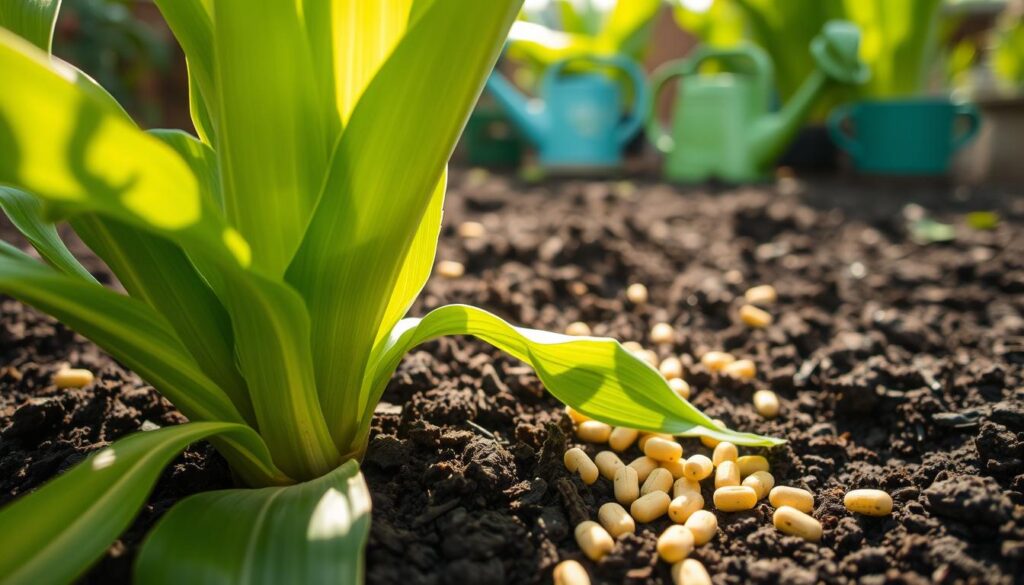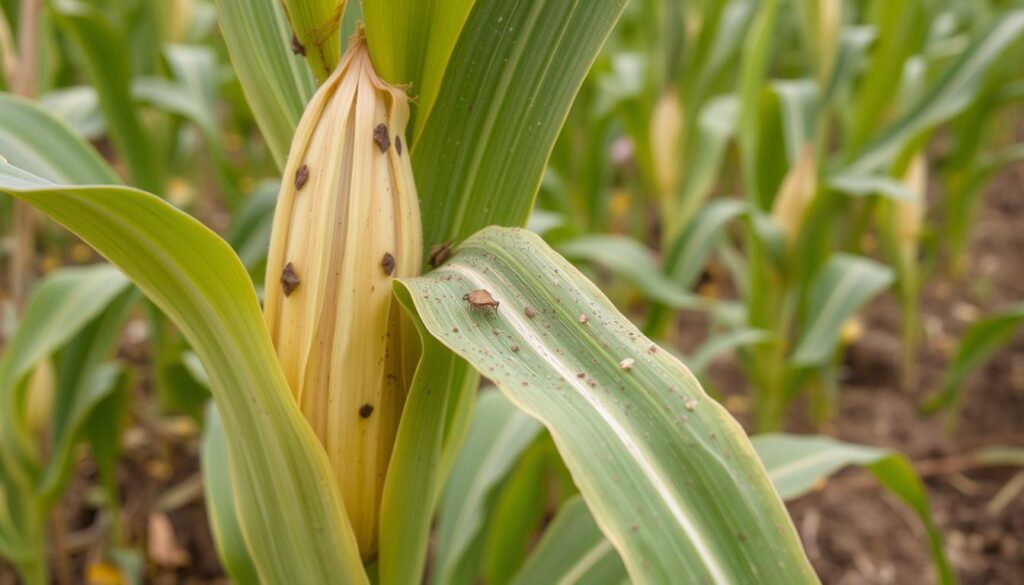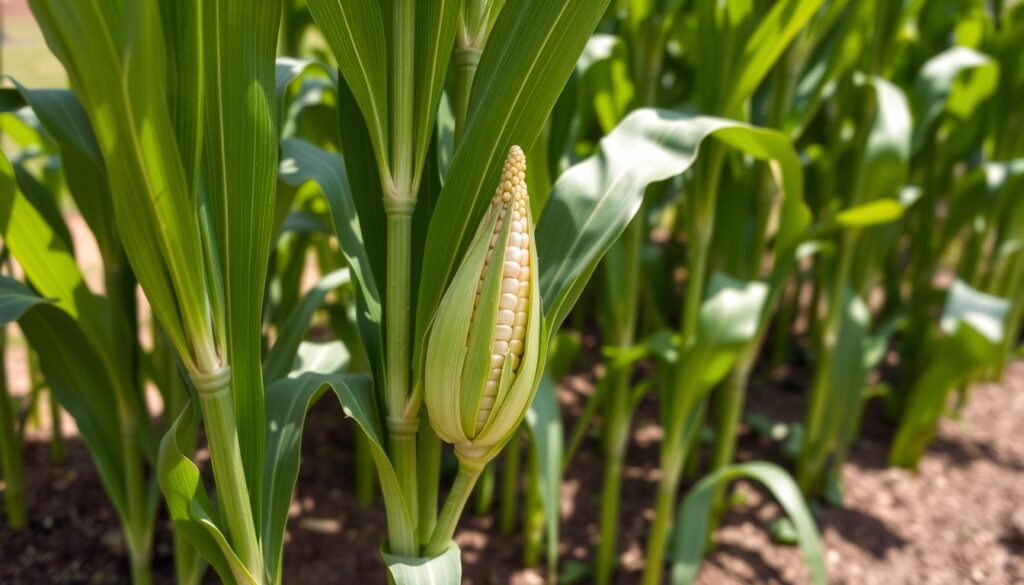Ready to add a touch of tropical beauty to your home? Corn plants are a great choice. They bring life and color to any room. But, how do you keep them thriving? Our corn plant care guide has all the tips you need to make your space a lush oasis.
Key Takeaways
- Corn plants are low-maintenance houseplants that can live for decades with proper care.
- These tropical plants prefer bright, indirect light and can tolerate a range of indoor environments.
- Watering and soil requirements are crucial for keeping corn plants healthy and thriving.
- Regular pruning and pest control measures help maintain the plant’s attractive appearance.
- Corn plants are known for their air-purifying abilities, making them a valuable addition to any indoor space.
Introduction to Corn Plants
What are Corn Plants?
Corn plants, also known as Dracaena fragrans, are tropical African evergreen trees. They have been popular indoor plants since the mid-1800s. Their long, narrow leaves look like corn stalks, earning them their name.
They are also called “false palms” because of their palm-like appearance.
Benefits of Growing Corn Plants Indoors
Corn plants can grow 4-6 feet tall, making them great for adding height indoors. They are easy to care for and can thrive in various light conditions. Plus, they help purify the air, making them a great choice for homes.
With their vibrant look and low maintenance, corn plants, or dracaena fragrans, are a favorite among many. They are a popular corn houseplant and indoor corn plant choice.
| Benefit | Description |
|---|---|
| Height and Greenery | Corn plants can grow up to 6 feet tall, adding vertical interest and lush foliage to indoor spaces. |
| Low Maintenance | These plants are relatively easy to care for, tolerating a range of light conditions and requiring minimal watering. |
| Air Purification | Corn plants can help remove toxins from the air, improving indoor air quality. |
“Corn plants are a wonderful addition to any indoor space, providing height, greenery, and even air purification benefits.”
Corn Plant Care Essentials
Light Requirements
Corn plants love bright, indirect light. Place them near a sunny window. But, avoid direct sunlight to prevent leaf scorch. They can handle some shade but might lose their bright colors. Grow lights help in dark spots.
Watering Needs
Let the soil dry a bit before watering. Check it weekly and water when the top inch is dry. Water less in fall and winter. Too much water causes root rot and slows growth. Too little water makes leaves wilt and die.
Temperature and Humidity Preferences
Corn plants do best in warm temperatures, 65 to 75 degrees Fahrenheit. High heat and low humidity make them lose water fast. They like humid air, 40-50%. Mist the leaves or use a pebble tray to boost humidity.
| Corn Plant Care Requirement | Optimal Range |
|---|---|
| Light | Bright, indirect light |
| Watering | Water when top inch of soil is dry |
| Temperature | 65-75°F (18-24°C) |
| Humidity | 40-50% |
| Fertilizer | Every 2-4 weeks during growing season |

“Corn plants thrive in temperatures between 65 and 75 degrees Fahrenheit.”
Soil and Potting
Choosing the right corn plant soil mix is key for your indoor corn plant’s health. These plants do best in a mix that drains well and is full of nutrients. Look for a mix made for houseplants or a mix of peat moss, perlite, and compost. Heavy, dense soils can cause root rot and poor drainage.
Best Soil Mix for Corn Plants
The perfect corn plant soil mix should have a few key traits:
- It should drain well to avoid waterlogging
- It should be rich in organic matter like compost or peat moss
- It should include aeration additives like perlite or vermiculite
- It should be slightly acidic, with a pH between 6.0 and 6.5
Repotting and Container Size
When you repot your corn plant, pick a container that’s 2-3 inches wider and deeper than the old one. This lets the roots grow without getting too crowded. Repot your corn plant every 1-2 years in the spring to refresh the soil and help it keep growing. Make sure the new pot has enough holes for drainage to avoid waterlogging.
| Corn Plant Container Size | Pot Diameter | Pot Depth |
|---|---|---|
| Starter/Young Plant | 6-8 inches | 6-8 inches |
| Mature Plant | 10-12 inches | 10-12 inches |
“Proper soil and container selection are critical for the long-term health and growth of your corn plant. Don’t skimp on these essentials!”
Fertilizing Corn Plants
Proper fertilization is key for corn plants to grow well. They need a balanced diet during their growing season. This helps them stay vibrant and healthy.
For your corn plant, use a liquid fertilizer. Apply it monthly in spring and summer at half strength. This helps them grow without burning their leaves.
Don’t fertilize in fall and winter. The plant is dormant and needs less food. Instead, flush the soil with water every few months. This keeps the soil fresh and nutrients balanced.
| Nutrient Requirement | Ideal Fertilizer N-P-K Ratio |
|---|---|
| Balanced Nutrients | 20-20-20 |
Stick to a regular corn plant fertilizer schedule. This promotes strong growth and lush leaves. Regular feeding corn plants with balanced fertilizer keeps them thriving.

“Proper fertilization is the foundation for a happy, healthy corn plant.”
Pruning and Maintenance
To keep your corn plant looking great, you need to prune and maintain it regularly. Using the right pruning techniques helps your plant grow better. It also makes it look nicer and keeps it healthy.
Trimming and Pruning Techniques
First, cut off any dead, damaged, or brown leaves with sharp pruners. This makes your plant look better and keeps diseases away. When you cut the main stalks, cut at a 45-degree angle. This helps prevent diseases and keeps your plant from getting too big.
By pruning correctly, your plant will grow more and look fuller. It will be more vibrant and beautiful.
Cleaning and Pest Control
Cleaning your corn plant regularly is key to its health. Use a damp cloth to wipe off dust and dirt from the leaves. This keeps your plant looking good and helps fight off pests like spider mites and scale insects.
If you find pests, deal with them quickly. This stops them from causing more harm.
“Pruning and cleaning your corn plant on a regular basis is the key to keeping it healthy and thriving.”
By following these corn plant maintenance tips, your indoor plant will stay lush and vibrant. A little pruning and care can make a big difference. Your corn plant will be happy and healthy.
How to Take Care of Corn Plant
Caring for a corn plant, also known as Dracaena Fragrans, is easy. It needs the right conditions to grow well. Whether you’re new to plants or have experience, these tips will help your corn plant thrive indoors.
Lighting and Placement
Corn plants love bright, indirect sunlight. Put your plant near a south or east-facing window for plenty of natural light. Don’t let it get direct sun, as it can burn the leaves. If it doesn’t get enough light, it might become leggy and lose its color.
Watering and Soil
Corn plants need well-draining, rich soil. Use a potting mix made for indoor plants or mix peat moss, perlite, and compost. Water when the top inch of soil is dry. Don’t overwater. In winter, water less to avoid root rot.
Temperature and Humidity
Corn plants do best in warm, humid places. Keep the temperature between 60-75°F (15-24°C). Aim for moderate to high humidity. Mist the leaves often or use a pebble tray to increase humidity.
Fertilizing and Pruning
Feed your corn plant with a balanced fertilizer every 4-6 weeks during growing season. Dilute it to half strength. Prune dead or damaged leaves to keep the plant looking good and encourage new growth.
With the right light, water, soil, and nutrients, your corn plant will flourish. It will add a tropical touch to your home. With proper care, it will be a long-lasting, easy-to-care-for friend.

Varieties of Corn Plants
The corn plant, also known as Dracaena fragrans, has many varieties. Each one has its own special leaves. The ‘Massangeana’ variety has leaves with a yellowish lime-green stripe down the middle.
The ‘Lindenii’ variety has leaves with yellow edges, not a stripe. The ‘Victoria’ variety has leaves similar to ‘Massangeana’ but are smaller and wider. Other varieties like ‘Lemon Lime’ and ‘Limelight’ have leaves in yellow and lime-green patterns.
| Cultivar | Leaf Characteristics | Unique Features |
|---|---|---|
| Dracaena fragrans ‘Massangeana’ | Yellowish lime-green central stripe | Most common corn plant variety |
| Dracaena fragrans ‘Lindenii’ | Yellow leaf edges | Contrasts with ‘Massangeana’ |
| Dracaena fragrans ‘Victoria’ | Smaller, wider, and almost triangular leaves | Similar to ‘Massangeana’ but with distinct leaf shape |
| Dracaena fragrans ‘Lemon Lime’ | Combination of yellow and lime-green hues | Adds visual interest with its color pattern |
| Dracaena fragrans ‘Limelight’ | Vibrant lime-green foliage | Stands out with its striking green tones |
These dracaena fragrans cultivars offer a wide range of choices for indoor gardens. Whether you like the classic ‘Massangeana’ or the unique ‘Lemon Lime’, there’s a corn plant for everyone.
Propagating Corn Plants
Corn plants, also known as Dracaena fragrans, can be easily propagated through both stem cuttings and seed propagation. This versatile approach allows you to grow new corn plant offspring from your existing plant. It’s a great way to expand your collection or share your love of these lush, tropical-inspired houseplants.
Stem Cutting Propagation
To propagate corn plants through stem cuttings, snip off a 6-8 inch section of the stem just below a leaf node. Place the cutting in a jar of water, making sure the lower portion is submerged. Once roots form, typically in about 8 weeks, plant the cutting in a moist potting mix.
The success of the propagation can be determined by the resistance felt when attempting to lift the stem after 8 weeks. Strong resistance indicates successful rooting.
Seed Propagation
For seed propagation, start by soaking the corn plant seeds in water for 3-5 days. This helps to soften the seed coat and promote germination. Next, plant the seeds in a seed starting mix, keeping the soil moist and warm until germination, which can take 4-6 weeks.
Once the seedlings develop two sets of true leaves, transplant them into individual pots. This allows for continued growth and development.
Both propagating corn plant methods allow you to cultivate new corn plant cuttings and grow corn plant from seed. This expands your collection of these versatile and air-purifying houseplants.

“Propagation is a great way to multiply your corn plant collection and share these beautiful, low-maintenance plants with friends and family.”
Overwintering Corn Plants
As winter approaches, your corn plants need extra care. These tropical plants love warm weather, making winter tough for them. To keep them healthy, prepare them well for the cold.
When it gets colder than 60°F, move your corn plant inside. You can either dig up the roots and pot them or cut off the top to grow new plants indoors. Make sure to protect your plant from cold drafts and direct sunlight.
Keep your corn plant’s humidity up by watering and misting lightly. Even though it needs less water, keep the soil a bit moist. This way, your overwintering corn plant will be ready to grow again when it’s warmer.
Looking after your corn plant in winter takes some extra work. But, seeing it come back in spring is worth it. Follow these tips to help your corn plant make it through the cold months and keep your home beautiful.
Common Problems and Solutions
Corn plants are easy to care for but can face issues like yellow leaves and pests. Taking the right steps can fix these problems and keep your plant healthy.
Yellowing or Browning Leaves
It’s normal for lower leaves to turn yellow and fall off. But if many leaves are yellow or brown, it’s a sign of a problem. Corn plant problems like not enough water, too much water, or not enough nutrients can cause this. Check the soil moisture and adjust your watering. Also, give your plant a balanced fertilizer to help it grow green again.
Pest Infestations
Corn plants can get pests like spider mites, thrips, and scale insects. It’s important to watch for pests and act fast. Use a damp cloth to clean leaves and treat pests with insecticidal soap or neem oil. Keeping your plant healthy and in good conditions can also help avoid pests.
| Problem | Cause | Solution |
|---|---|---|
| Yellowing Leaves | Underwatering, Overwatering, Nutrient Deficiency | Check soil moisture, Adjust watering, Fertilize with balanced fertilizer |
| Browning Leaves | Underwatering, Excessive Light, Nutrient Deficiency | Check soil moisture, Adjust watering and lighting, Fertilize with balanced fertilizer |
| Pest Infestations | Spider Mites, Thrips, Scale Insects | Wipe down leaves, Treat with insecticidal soap or neem oil |
By quickly fixing problems like yellow leaves and pests, you can keep your indoor corn plant healthy and looking good. Regular care and watching for issues are important to prevent and solve common problems.

Blooming and Fragrance
Corn plants are loved for their lush, tropical leaves. But the real joy is seeing their rare blooms. These plants bloom once to three times a year, especially when they’re over 5 years old.
The blooms come from the center of the leaves and can grow up to 3 feet long. They have white, spiky flowers that smell sweet and fragrant.
The scent of the blooms is like jasmine, lilac, honey, and fresh grass. These flowers open at night and close by day. A new bloom opens every evening for about a month.
Seeing the corn plant flowers at night is a special treat. It shows the hard work and care of the indoor gardener.
Indoor corn plants don’t bloom as often as outdoor ones. But their corn plant fragrance is still enchanting. Plants in warm places bloom once or twice a year with warm white or pale pink flowers.
For indoor growers, waiting for blooms is worth it. It shows the plant is healthy and thriving.
| Characteristic | Indoor Corn Plants | Outdoor Corn Plants |
|---|---|---|
| Blooming Frequency | Rare, if ever | Once or twice a year |
| Bloom Color | White with pale yellow anthers | Warm creamy white or pale pink |
| Bloom Time | Open at night, drop by day | Open at night, drop by day |
| Flower Stalk Height | Up to 3 feet | Up to 3 feet |
| Fragrance | Sweet, floral, and earthy | Sweet, floral, and earthy |
Seeing a mature corn plant bloom is a joy for indoor gardeners. These rare moments remind us of nature’s beauty, even in our homes.
Corn Plants for Air Purification
Corn plants (Dracaena fragrans) are not just pretty; they also clean the air. NASA’s Clean Air Study found they remove harmful stuff like formaldehyde and benzene. This makes them great for indoor air.
The Dracaena fragrans, or Corn Plant, can grow up to six feet tall. They love bright, indirect light. This makes them perfect for homes and offices, improving air quality.
Having a corn plant air purifier can calm you down. It reduces stress and makes you feel more relaxed. It also gets rid of harmful chemicals, making the air better.
The Corn Plant also adds moisture to the air. This is good for places that are too dry. It helps keep the air comfortable.
The Dracaena fragrans can help you sleep better, boost your immune system, and improve your thinking. Adding one to your space can make it healthier and more peaceful. You’ll enjoy cleaner air and a calmer place.

“Keeping a corn plant in your home or office can help improve air quality and create a healthier living space.”
Conclusion
Corn plants, or Dracaena fragrans, are great for indoor spaces. They need the right care to thrive. This includes proper lighting, watering, and temperature.
Regular pruning, feeding, and pest monitoring keep your corn plant healthy. This ensures it continues to beautify your home.
Whether you’re caring for or growing a corn plant indoors, this guide has you covered. It offers tips on light, watering, and more. You’ll learn how to create a lush, air-purifying space.
Corn plants can grow up to 6 feet tall and purify the air. They’re perfect for plant lovers and homeowners. Follow the advice in this article to enjoy your corn plant’s benefits for years.


